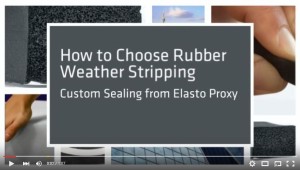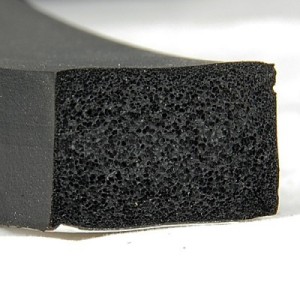
Rubber weather stripping provides either static or dynamic sealing. Sealing pressure is essential, and some elastomers are more resilient than others. Technical buyers and product designers need to compare open cell and closed cell rubber, specify the durometer or hardness, and choose the right compound.
Rubber weather stripping prevents the flow of air and water between two surfaces, such as a door and door frame. Standard weather stripping may be suitable for residential use, but applications in the automotive, building and construction, and electronics industries often require a custom sealing solution. Custom-fabricated weather stripping ensures part quality while speeding installation and reducing material waste.
But what do buyers and designers need to know about weather stripping selection? Let’s take a look.
Static Sealing vs. Dynamic Sealing
For starters, technical buyers and product designers must determine whether their application involves static sealing or dynamic sealing. Static seals are used when there’s no relative motion between two mating surfaces. For example, because the windows in a skyscraper don’t open, their window seals are static seals. Conversely, dynamic seals are used when there’s relative motion. Think of the front door to a skyscraper. The door opens and closes regularly, so the seal between the door and the frame is dynamic.
Sealing Pressure and Resiliency
 The way that a static seal or a dynamic seal works is what affects weather stripping selection. Remember that static seals operate within a confined space. Pressure between the two mating surfaces is relatively stable, and deforms and reshapes the seal. This provides a tight fit and prevents the flow of gases and liquids. Dynamic seals are also sandwiched between two surfaces, but these surfaces move. Motion changes sealing pressure, but a dynamic seal needs return to its “resting pressure” once movement is complete.
The way that a static seal or a dynamic seal works is what affects weather stripping selection. Remember that static seals operate within a confined space. Pressure between the two mating surfaces is relatively stable, and deforms and reshapes the seal. This provides a tight fit and prevents the flow of gases and liquids. Dynamic seals are also sandwiched between two surfaces, but these surfaces move. Motion changes sealing pressure, but a dynamic seal needs return to its “resting pressure” once movement is complete.
As rubber is compressed over time, however, it loses its ability to return to its original thickness. Ultimately, this loss of resiliency can cause the seal to leak, permitting the flow of air and water. In the case of rubber weather stripping on an exterior door, air can enter the building and (depending on the temperature outside) either increase or decrease the temperature inside. In turn, the building’s HVAC system works harder at heating or cooling. Fuel and maintenance costs rise accordingly.
Open Cell Rubber vs. Closed Cell Rubber
Elastomers with cellular structures can be soft enough to compress, yet still resilient enough to support long-term sealing. There are two basic types of cellular rubber – and many different compounds. Open-cell rubber contains interconnected pockets that permit the passage of air and water when the seal is not compressed. Closed-cell rubber contains balloon-like, gas-filled cells that prevent the passage of these substances at low pressures.
Again, static vs. dynamic sealing is important. For example, because static seals remain compressed, open-cell rubber may seem like a natural choice. Yet temperature changes can cause mating surfaces such as glass windows and metal window frames to increase or decrease seal compression. In skyscrapers where exterior surfaces are exposed to hot temperatures in summer and cold temperatures in winter, the expansion and contraction of metal and glass must be considered.
Durometer and Compound Selection
Don’t forget durometer either. The hardness of an elastomer also affects its compressibility. Just consider the difference between a high-durometer hockey puck and a low-durometer pencil eraser. Which one is easier to squeeze? Remember, too, that not all cellular materials are sponge-like. Closed-cell rigid insulation is a common building material, but it’s not used for door or window seals. Typically, industrial and automotive weather stripping consists of medium-durometer foam or sponge rubber materials.
Each rubber compound has particular properties, so technical buyers and design engineers need to consider all of their requirements. For sealing applications that require oil resistance and aging resistance, neoprene rubber is a good choice. EPDM rubber provides good weather resistance, and silicone rubber withstands high and low temperatures.
Custom Fabrication and Adhesive Backings
As an experienced custom-fabricator of industrial rubber products, Elasto Proxy can supply you with the right rubber weather stripping for your specific application. Our solutions providers are ready to answer your questions about seal selection, and can explain how custom weather stripping with an adhesive backing gets cut-to-size and arrives ready-to-install.
How can we help you meet your requirements for rubber weather stripping? Contact us today.











